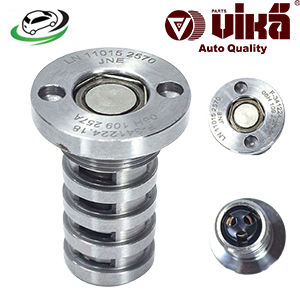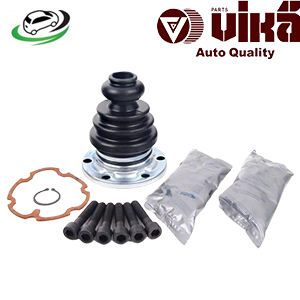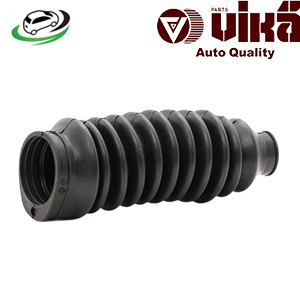-20%
Get Steering Rack Boot VW Cabrio III/Golf III/Jetta III/Passat B3/ Passat B4 1H0422831B
The steering rack boot, a seemingly modest component in your vehicle’s steering system, plays a crucial role in ensuring safe and smooth driving. It’s designed to protect the steering rack from contaminants, ensuring its longevity and efficient operation. This guide will explore the function, construction, benefits, common issues, and maintenance of the steering rack boot in detail.
What is a Steering Rack Boot?
The steering rack boot is a flexible, rubberized cover that encases the steering rack’s inner and outer tie rods. The steering rack, which is part of the steering system, translates the rotational motion of the steering wheel into lateral movement of the wheels. The steering rack boot protects this critical component from dust, dirt, moisture, and other debris that could cause premature wear or damage.
Function of the Steering Rack Boot
- Protection from Contaminants:
- Dust and Dirt: The boot shields the steering rack and tie rods from dust and dirt, which can lead to abrasion and accelerated wear if they enter the system.
- Moisture: By preventing moisture from entering, the boot helps to avoid rust and corrosion on the metal components of the steering rack.
- Prevention of Hydraulic Leaks:
- Seal Integrity: The steering rack boot also helps maintain the integrity of the hydraulic seals within the steering rack. If contaminants were to breach the boot, they could damage the seals and lead to hydraulic fluid leaks.
- Smooth Operation:
- Reduced Friction: By keeping debris out, the boot ensures smooth movement of the steering rack and tie rods, contributing to the overall smoothness of the steering system.
Construction of the Steering Rack Boot
- Material:
- Rubber or Synthetic Rubber: Steering rack boots are typically made from durable rubber or synthetic rubber materials, such as neoprene or nitrile. These materials are chosen for their flexibility, resistance to abrasion, and ability to withstand exposure to oils and chemicals.
- Reinforced Fabric: Some boots may include a layer of reinforced fabric within the rubber to enhance durability and resistance to tearing.
- Design:
- Flexible Construction: The boot is designed to be flexible to accommodate the movement of the steering rack and tie rods while maintaining a tight seal.
- Elasticity: The material must be elastic enough to stretch over the steering components but also resilient enough to return to its original shape after movement.
- Attachment Mechanisms:
- Clamps: The boot is secured to the steering rack and tie rods using metal or plastic clamps. These clamps ensure that the boot remains in place and provides a seal against contaminants.
- Sealed Ends: The ends of the boot are usually sealed with a lip or flange that fits snugly around the steering components to prevent leaks and entry of debris.
Benefits of a Steering Rack Boot
- Enhanced Longevity of Steering Components:
- Protection from Wear: By preventing contaminants from reaching the steering rack and tie rods, the boot significantly extends the lifespan of these components.
- Reduced Maintenance Costs: Properly functioning boots reduce the need for frequent repairs or replacements of the steering system, leading to cost savings over time.
- Improved Steering Performance:
- Smoother Operation: The boot helps maintain smooth operation of the steering system by keeping out debris and ensuring proper lubrication of moving parts.
- Accurate Steering Response: A well-maintained steering rack contributes to precise steering response, enhancing driving safety and comfort.
- Prevention of Hydraulic Fluid Leaks:
- Seal Protection: By safeguarding the hydraulic seals from contaminants, the boot helps prevent leaks of hydraulic fluid, which is crucial for the proper functioning of power steering systems.
- Reduced Risk of Corrosion:
- Rust Prevention: The boot prevents moisture from contacting metal components, reducing the risk of rust and corrosion, which can lead to more serious damage.
Common Issues with Steering Rack Boots
- Cracking or Splitting:
- Causes: Over time, exposure to harsh environmental conditions, such as extreme temperatures and UV radiation, can cause the rubber to crack or split.
- Symptoms: Cracks or splits in the boot can lead to visible leaks of steering fluid or entry of debris into the steering rack.
- Tearing or Ripping:
- Causes: Physical damage from road debris or improper installation can cause the boot to tear or rip.
- Symptoms: A torn or ripped boot can allow dirt and moisture to enter the steering rack, leading to potential damage.
- Boot Deformation:
- Causes: Prolonged exposure to excessive heat or pressure can cause the boot to lose its shape or become deformed.
- Symptoms: Deformation can affect the boot’s ability to seal properly, potentially leading to leaks or contamination.
- Clamping Issues:
- Causes: Loose or improperly installed clamps can cause the boot to shift or come off, compromising its effectiveness.
- Symptoms: Loose clamps can lead to the boot becoming detached or failing to provide a proper seal.
Diagnosing Issues with Steering Rack Boots
- Visual Inspection:
- Check for Damage: Regularly inspect the steering rack boots for signs of cracks, splits, or tears. Look for any visible leaks of steering fluid around the boots.
- Examine Clamps: Ensure that the clamps securing the boots are tight and in good condition.
- Steering Performance:
- Assess Steering Feel: Pay attention to any changes in steering feel, such as increased resistance, unusual noises, or vibrations, which may indicate a problem with the steering rack boots.
- Monitor Fluid Leaks: If you notice steering fluid leaking under the vehicle, it may be a sign of a compromised boot.
- Professional Inspection:
- Mechanic’s Assessment: If you suspect an issue with the steering rack boots, have a professional mechanic inspect the boots and the steering system. They can perform a thorough examination and identify any potential problems.
Replacing Steering Rack Boots
- When to Replace:
- Visible Damage: Replace the steering rack boots if you observe any signs of cracking, tearing, or significant wear.
- Performance Issues: If the steering system exhibits problems such as fluid leaks or poor performance, inspect and replace the boots as needed.
- Replacement Procedure:
- Lift the Vehicle: Raise the vehicle using a jack and secure it with jack stands to access the steering components.
- Remove Old Boots: Detach the clamps and carefully remove the old steering rack boots from the steering rack and tie rods.
- Install New Boots: Position the new boots over the steering components, ensuring they are properly aligned and secured with clamps.
- Check for Proper Fit: Ensure the new boots are securely attached and that there are no gaps or leaks.
- Post-Replacement Checks:
- Inspect for Leaks: After installation, check for any signs of steering fluid leaks around the new boots.
- Test Steering: Test the steering system to ensure smooth operation and proper performance.
Maintenance Tips for Steering Rack Boots
- Regular Inspections:
- Routine Checks: Periodically inspect the steering rack boots for signs of wear or damage, especially if you drive in harsh conditions.
- Look for Leaks: Monitor for any signs of steering fluid leaks or changes in steering performance.
- Protect from Damage:
- Avoid Physical Impact: Take care to avoid hitting road debris or curbs that could damage the steering rack boots.
- Keep Clean: Regularly clean the area around the steering rack boots to prevent the buildup of dirt and grime.
- Prompt Repairs:
- Address Issues Early: If you notice any damage or issues with the steering rack boots, address them promptly to prevent further damage to the steering system.
Follow us on Facebook for more parts.



